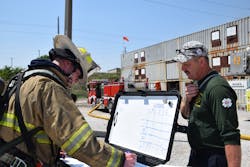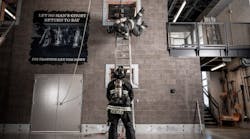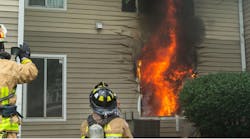Whether you are a probationary firefighter or a seasoned veteran, you participate in many hours of training throughout your career in the fire service. As your career advances, you might go on to become an instructor or even a training officer. Once in such a position, how do you determine what topics to teach and how to craft those trainings? Do you teach to an established schedule, or do you just “wing it”?
To improve your training program, you can implement the ADDIE model.
What is ADDIE?
ADDIE is an instructional design model that was created in the 1970s. Originally developed for the U.S. Army, ADDIE later was implemented across all of the branches of the U.S. Armed Forces. Even though the model is more than 50 years old, the underpinning methodology has stood the test of time. ADDIE remains a leading learning design methodology to this day.
ADDIE is an acronym that stands for analysis, design, development, implementation and evaluation.
Analysis
When looking at future training, you first must analyze your training needs. This first part of the model is also where you start to set your goals. Is your training based off of a generic schedule, or are you looking at your community to help to decide what specific training should be held?
Once this is determined, you analyze what existing training material you have or had and whether you must update that material and/or need additional resources for the delivery of the training.
Lastly, analyze the particular job and the tasks that are associated with it. Is this something new to your department, and how do you break it down to manageable tasks that lead you to the overall objective?
For example, as a previous training officer who lived in a rural community that was next to a busy interstate, I did some research on our previous year’s trainings and realized that we needed to ensure that our annual trainings included vehicle extrication and LP gas training. We regularly got called to the interstate for accidents. Furthermore, living in a rural community, there were plenty of farms, which meant that there were plenty of LP tanks in the area. We needed to make sure that our firefighters and EMTs were trained in how to mitigate these incidents.
Design
The next step to ADDIE is the design phase. You start by creating an outline and designing the learning objectives. What is your goal, and how do you get there?
Objectives are the steps to your goal. Are you identifying objectives for individual performance, or are you looking at objectives that are based on a team’s performance? Are you raising a ladder? Are you ventilating a roof?
Once you identify those objectives, you can design the content outline and create the performance measures. Performance measures are those skills that determine the quality and effectiveness of your objectives. These measures also can be called key performance indicators, or KPIs.
In creating objectives, don’t forget to consider those skills or outcomes that you hope to achieve during training.
Development
This step is where you develop your lesson plan(s), any audio/visual or other supporting media that you might need, support materials that accompany your training and a syllabus that includes a schedule of how the training will progress. The syllabus also includes the references that support the content of your training program.
When it comes to references, make sure to use the most current textbooks and national standards. This helps to strengthen the credibility of training material. We are in a time when technology is our friend and should be used as a tool to help to enhance learning.
A quick note regarding the use of audio/visual materials: Keep the materials relevant to the training and try to avoid the trap of “death by PowerPoint.” If you use a PowerPoint presentation, keep it to three or four bullet points per slide and only six words per line. Remember that we are a hands‐on type of people when it comes to training, so PowerPoint should only serve as a memory cue for the presenter.
In the development phase, you also can run a pilot test of the training. A pilot test and the feedback/observations that are collected offer insight into final adjustments that should be made before implementing the final product.
Implementation
It is now time to implement the training and curriculum that you created. Implementation is the presentation of your training materials to your intended audience.
Ensure that your presenters are well prepared and familiar with the content.
Use your time wisely during this phase. There’s a saying that “we train like we play,” but be smart. A wise man once said, ‘When it comes to training, I don’t want you to be safe. I want you to be smart. A smart firefighter is inherently safe.”
Evaluation
After you analyzed, designed, developed and implemented your training, you must evaluate its effectiveness. How do you do that? There are various methods available to evaluate performance. Examples include written exams, to measure comprehension, and hands‐on demonstrations. If you use a formal exam, ensure that the questions come directly from the material that was presented.
Also, evaluators must be familiar with the tasks that were demonstrated by the students and aware of any conditions that were imposed on the evaluation (e.g., time limits, open‐book vs closed-book).
A summative evaluation is conducted after implementation and, generally, at three levels:
- Level 1: Perception—measures the degree of participant satisfaction.
- Level 2: Learning—measures acquisition of knowledge and skills.
- Level 3: Performance—measures transfer of newly acquired knowledge and skills to an actual work environment.
The evaluation feedback that you receive will help you to decide how successful the training was and whether you must make any modifications to that particular training.
Don’t let this feedback go unnoticed. Share the evaluation feedback with the other officers. It’s important that this feedback helps you to update, or revise, the next iteration of that training.
This brings us to the next “unofficial” part of the ADDIE model: revise.
Revise
After you evaluate your program, it’s time to revise, or make any adjustments, to your training program for the next year. Standards are revised, technology improves, and research advances our knowledge. The information that you present to your students must indicate these changes. It becomes incumbent on you, as the course designer or training officer, to keep up with the industry and to revise course content, to ensure that your training remains current and relevant to your students.
You might need to revisit the design phase to adjust the objectives, then move to the development phase to update your lesson plans and PowerPoint presentations.
After you develop the next version of that training, it’s ready to implement for the next time that you train on that topic.
Meeting specifications
The ADDIE model is a process that can enable you to seamlessly create training to meet your specific needs. When it was first explained to me, I realized that I developed many trainings using the ADDIE model without knowing it.






